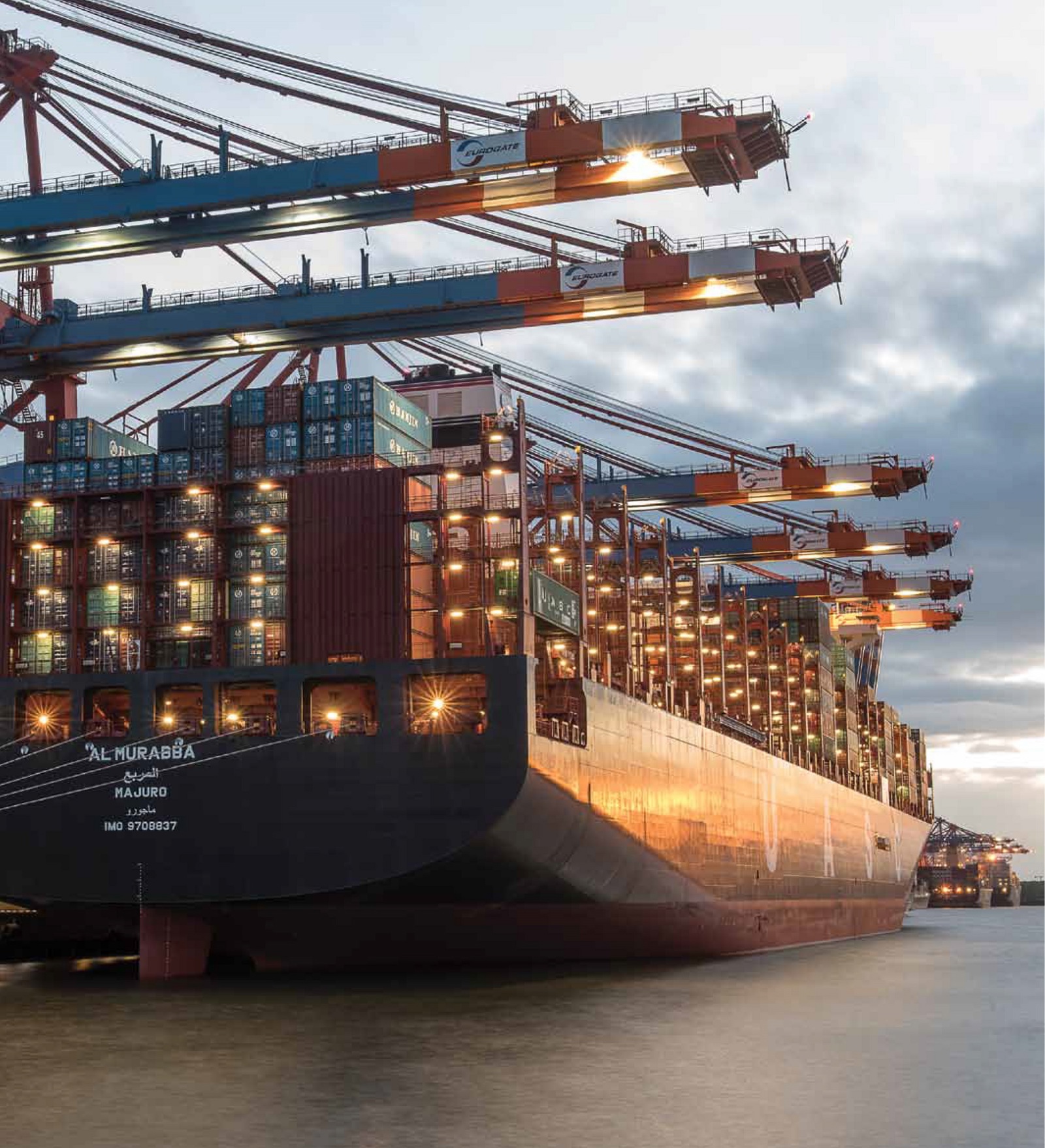
United Arab Shipping Company (UASC) thinks big. The firm, based in Dubai, is in the middle of a fleet expansion programme worth over USD2.3 billion and recently took delivery of its first ultra-large 18,800 TEU vessel, the M.V. Barzan. But while the scale of its plans generates the headlines, it’s the thinking behind them that will help UASC make waves far into the future
-
Text:Kongsberg Maritime Communication
-
Gunvor Hatling MidtbøVice President, Communications
The M.V. Barzan tells you everything you need to know about UASC. Delivered from Hyundai Heavy Industries earlier this year, its most obvious characteristic is its jaw-dropping scale. At 400 m long and 58 m wide, weighing-in a shade under 200,000 dwt, this towering vessel is amongst the world’s very largest container ships. This neatly mirrors the magnitude of UASC itself, a global leader in its field with more than 185 international offices and 60 ships, serving 240 ports and destinations worldwide. But look beyond this mass of steel and you see what really drives both the Barzan and the company – a relentless quest for efficiency. Size is merely a facilitator on the path to the objective of setting new standards in eco-efficiency for the highly competitive container segment. A goal that UASC, in partnership with Kongsberg Maritime, is determined to achieve.
COMPLETE COMMITMENT
At its launch, Barzan was instantly acclaimed as the industry’s most eco-efficient container vessel, with a CO2 output per TEU of more than 60% below a 13,500 TEU vessel delivered just three years ago. That staggering improvement is achieved, Mohamed Zaitoun, Assistant Vice President New Building Technical Projects UASC, explains, partially through scale efficiencies, but also through a concerted effort to think holistically about optimising total vessel performance.
“When it comes to efficiency we consider and address everything we can,” he states. “The engine, automation system, propulsion, controls, port operations, navigation, total operational costs… every element. By optimising these individually we create a better whole.
“In theory that’s simple, in practice it takes complete commitment.”
Commitment is something that isn’t in short supply at UASC – as demonstrated by a current newbuild programme that encompasses eleven 15,000 TEU and six 18,800 TEU vessels, all of which are scheduled to be delivered by 2016.
The six larger ships, of which the Barzan is the first, boast an EEDI (Energy Efficiency Design Index) value that is close to 50% below the 2025 limit set by IMO, are constructed ‘LNG ready’ (with the main infrastructure for LNG fuel supply in place) and boast an array of environmentally friendly solutions. These include shore-toship power supply for zero emissions at berth and energy efficient integrated on-board systems, key elements of which have been supplied by KONGSBERG

THE POWER OF TECHNOLOGY
“Technology is a key differentiator when it comes to achieving greater efficiency and maximising performance on large merchant vessels,” comments Zaitoun. “We choose suppliers we know we can rely on – those with both a proven track record and the stability to be with us for the long term future – but also those that are prepared to invest heavily in R&D to find innovative solutions that deliver a competitive edge.”
UASC selected Kongsberg Maritime to provide a Full Picture solution for its newbuilds, delivering integrated vessel control systems for navigation, communication, and automation for machinery and propulsion systems (K-Chief). The contract also includes a state of the art, Vessel Performance System, which monitors and provides accurate, detailed decision support advice for operators regarding energy efficiency, fuel usage and optimal sailing. Together these systems integrate with the electronically controlled main engines, maximising fuel efficiency, while reducing noise, vibration and carbon emissions by automatically controlling fuel consumption in line with sailing speed and conditions.
“This kind of advanced solution allows us to be proactive in our decision making, and this leads to cost, as well as environmental, savings,” Zaitoun says.
“These days, when competition is fierce and margins are so
small, this technology gives us greater control of the vessels and
that can reduce operational costs, to the benefit of all our stakeholders.”

Barzan naming ceremony: Celebrating the arrival of a new age of eco-efficiency.
HIGHS AND LOWS
Of course, ‘these days’ fuel prices have also plummeted to new lows. Does that not influence UASC’s thinking when it comes to the current fleet renewal? Is efficiency still King when operational costs are softer?
Zaitoun’s feelings are crystal clear: “We are building these ships
for optimal operations over the next 20 to 25 years. The fuel cost may be low now, but no one knows what’s going to happen over the course of the next few years, or even months.
“Currently fuel accounts for almost half of the total operational cost, so it makes economical sense to control that expenditure as much as possible. All shipowners have to control costs, and UASC is no exception.”
Where the firm is perhaps exceptional is in its commitment to
the very highest environmental standards. Cost, as outlined by Zaitoun, is important, but so is its image as an eco frontrunner.
Zaitoun, as with all the UASC management team, speak as one on the issue of the environment. Jørn Hinge, the company President and Chief Executive Officer, noted in 2015 that “providing environmentally friendly transport solutions and recognising environmental initiatives around the globe are no longer a choice; they are a necessity for both our organisation and our customers.”
Zaitoun explains more: “The future is uncertain, but what we do know is that environmental issues and challenges are going to increase in gravity and scope. We all have a duty to mitigate potential environmental impact in whatever way we can and that commitment is clearly illustrated in all our newbuilds.
“We are not here for the short-term. UASC, and all its customers, are interested in sustainable industry and responsible operations.
We do everything we can to ensure that, from helping our customers monitor their carbon footprints through greater transparency and accountability, to enhancing our own bunker efficiency, targeting port punctuality, and conducting regular energy efficiency training across the organisation, co-ordinated by the HSSEQ department.
“Eco-efficiency defines what we do,” he concludes, adding: “Everybody benefits from that.”
The Barzan is now setting out to ply the Asia-Europe trades as part of UASC’s Ocean 3 services. There, enabled by the firm’s commitment, and assisted by Kongsberg Maritime technology, it will deliver “the industry’s lowest per-container levels of CO2 output.” And that, without a shadow of doubt, is really big news